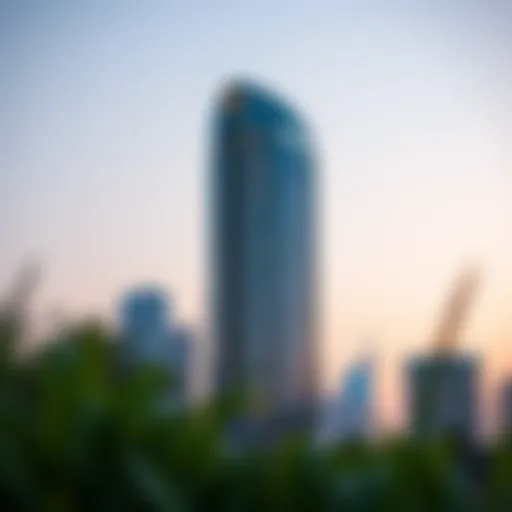Bur Dubai Abra Station: Location and Importance
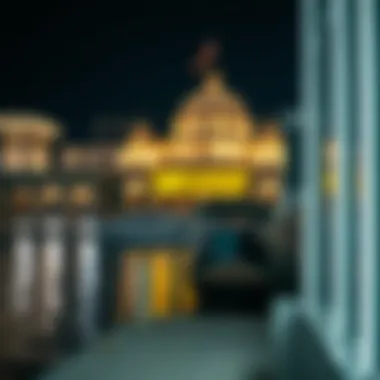

Intro
Bur Dubai Abra Station does not simply exist as part of Dubai’s transportation network; it serves as a vibrant tapestry weaving together the past and present. Tucked into the heart of old Dubai, this ferry station goes beyond the basic function of moving passengers across the historic Dubai Creek. It embodies a rich historical context and stands as a gateway for community interaction, tourism, and investment potential.
Positioned strategically, the station is a critical junction that connects different neighborhoods, enhancing accessibility for residents and tourists alike. The station’s location showcases the unique blend of the traditional and modern, as it sits comfortably amidst bustling markets, ancient souks, and contemporary developments. As Dubai continues to grow and evolve, the significance of Bur Dubai Abra Station only escalates, making it an essential focal point for anyone looking to understand the dynamics of this remarkable city.
Foreword to Bur Dubai Abra Station
The Bur Dubai Abra Station serves as a vital artery in Dubai's bustling heart, enabling seamless connectivity and imbued with layers of history. This station is far more than just a transit point; it symbolizes the very spirit of a historical city that smoothly intertwines tradition and modernity. Understanding its pivotal role in Dubai‘s infrastructure can shed light on the broader narrative of the city’s development and its evolving role within the Gulf region. Through this exploration, readers gain insights into local culture, commerce, and the everyday experiences of both residents and tourists.
Overview of Abra Services
Bur Dubai Abra Station is renowned for its Abra services, a distinctive form of transportation that dates back centuries. These traditional boats shuttle across Dubai Creek, offering not only a means to traverse but also a glimpse into the heritage of the emirate. Each ride on an Abra, a punctuated affair, clinks and clatters with the sound of water against wood, inviting the senses into a tapestry of heritage and contemporary life.
- Affordability: The fare is modest, making it accessible to all, from bustling traders to wandering tourists. It typically costs about one Dirham per crossing, making it one of the most economical transportation options around.
- Frequency: These vessels operate at frequent intervals, ensuring that passengers do not have to wait long to hop aboard, thus seamlessly integrating with the daily hustle of the city’s life.
- Capacity: Each Abra can accommodate around 20 passengers, allowing for a communal experience that fosters social intermingling.
Visitors using the service are often treated to stunning views of the old and new Dubai. As they glide across the creek, they witness the kaleidoscope of sights: ancient souks, towering skyscrapers, and, on occasion, the playful splash of a fish breaking the surface.
Historical Significance
The historical significance of Bur Dubai Abra Station is not to be understated. It stands as a monument to Dubai’s roots, where trade and cultural exchange first flourished. The Abra service connects two pivotal districts—Bur Dubai and Deira, both of which are integral to the city’s economy and heritage.
- Cultural Exchange: Historically, the creek has served as a conduit for merchants and traders from various cultures, bolstering the city’s reputation as a trading hub. This nexus drove economic growth and nurtured relationships across communities.
- Preservation of Tradition: Today, the station preserves this rich tradition within the checks and balances of modernization. While high-tech options like water taxis may exist, the Abra offers a sentimental experience, reminding locals and visitors of days gone by.
- Symbolic Landmark: With its roots firmly planted in the history of the region, the Abra Station itself has become a landmark, embodying Dubai’s journey from a modest pearling and trading post to a global city known for its innovation and progress.
In sum, the Bur Dubai Abra Station serves a multitude of roles—transportation node, historical marker, and cultural ambassador—making it a cornerstone of both Dubai’s past and its ever-evolving future.
Geographical Context
Understanding the geographical context of Bur Dubai Abra Station is crucial for grasping its significance not just as a transportation node, but as a vibrant connector of cultures and communities within the city. Situated strategically, Bur Dubai Abra Station is more than just a dock for traditional wooden boats. It embodies the essence of local life, bustling with residents and tourists alike, who come to experience the rich tapestry of Dubai's heritage and modernity.
Location in Bur Dubai
Nestled in the historic Bur Dubai district, Abra Station holds a key geographical position that enhances its functionality. The neighborhood itself is steeped in the history of Dubai, showcasing beautiful contrasts between contemporary architecture and the remnants of a bygone era.
The station is bordered by the idyllic Dubai Creek, a natural waterway that has historically been a lifeline for trade and transport. This positioning allows for easy access to not just local neighborhoods, but also several cultural landmarks, making it an ideal launchpad for exploring the area.
Proximity to Key Landmarks
Bur Dubai Abra Station's location is pivotal, as it lies in proximity to several landmarks that are essential to understanding the cultural and economic landscape of Dubai. Each landmark functions as a gateway to experiences that encapsulate the spirit of the city.
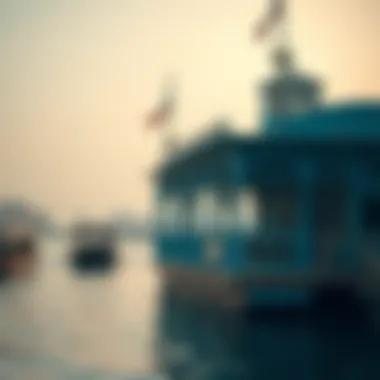

Dubai Creek
One cannot discuss the significance of Bur Dubai without mentioning Dubai Creek. This waterway serves not just as a transportation route but as a cultural icon. The creek's winding shape adds a unique charm to the area, inviting both locals and tourists to admire its beauty.
- Key Characteristic: It acts as a natural divider between Bur Dubai and Deira, facilitating the flow of trade and life.
- Unique Feature: One especially appealing aspect of Dubai Creek is its vibrant marina area where traditional dhows and modern yachts coexist. This blend provides a picturesque scenery and serves as a reminder of Dubai's rich trading history.
- Advantages/Disadvantages: While the proximity to the creek enhances aesthetic value and tourism, it can sometimes lead to congestion, especially during peak tourist seasons.
Textile Souk
Another gem nearby is the Textile Souk, where the air is fragrant with the aromas of spice and textile dyes. This marketplace is an essential part of Dubai's fabric—quite literally. Here, intricate fabrics and textiles tell stories of tails spun through generations.
- Key Characteristic: The souk caters to a diverse clientele, offering everything from silks to cotton, appealing to both expatriates and locals.
- Unique Feature: The vibrant colors and lively bargaining create a bustling atmosphere that captures the essence of Middle Eastern market culture.
- Advantages/Disadvantages: However, the narrow alleyways can be overwhelming during busy periods, and the charm can give way to discomfort as the crowds grow.
Al Fahidi Historic District
Just a stone's throw away is the Al Fahidi Historic District, a treasure trove of traditional architecture and cultural heritage. Walking through its narrow lanes is like stepping back in time, surrounded by wind-tower buildings that illustrate Dubai’s architectural ingenuity.
- Key Characteristic: This area is rich in museums, art galleries, and cultural events, making it a cultural hotspot that draws visitors year-round.
- Unique Feature: The juxtaposition of modern art within the historic framework of the district creates an intriguing narrative, fostering an appreciation for both past and present.
- Advantages/Disadvantages: Despite its charm, preservation efforts are always a challenge, as the area faces pressure from development, which could dilute its historical significance.
In summary, the geographical context of Bur Dubai Abra Station is not merely defined by its location, but by the interconnectedness of the surrounding landmarks. Each contributes to the socio-economic landscape of the area, making the station a vital part of Dubai’s urban ecosystem.
Transportation Integration
The Transportation Integration of Bur Dubai Abra Station plays a pivotal role in the daily hustle and bustle of Dubai's urban life. As a key node in the city’s public transport network, the station serves not only to move people but also to link diverse communities and enhance complex logistical connections. Understanding this aspect is crucial for recognizing how Bur Dubai Abra Station fits into the broader picture of Dubai’s transport framework.
Linking Communities
Bur Dubai Abra Station acts as a vital artery connecting various neighborhoods along the banks of Dubai Creek. The traditional abra, a small wooden boat, offers a direct link between the two contrasting sides of the creek – Bur Dubai and Deira. This connection is more than just a physical one; it symbolizes the mingling of cultures, lifestyles, and traditions. For many residents and visitors alike, the abra ride is not just a means of transportation but a journey through history.
- Community Cohesion: The station fosters a strong sense of community. Local traders, artisans, and residents frequently use the service, ensuring a continuous flow of daily life.
- Cultural Exchange: Passengers from diverse backgrounds share the abra space, promoting dialogue and understanding amongst different cultures in Dubai.
The function of Bur Dubai Abra Station extends beyond mere transportation. It supports economic activities, allowing small businesses to thrive by connecting them directly with potential customers from both sides of the creek.
Public Transport Connections
For a seamless travel experience, Bur Dubai Abra Station is strategically integrated with other forms of public transport. This is crucial for those wishing to explore the city further or commute for work. The efficiency and accessibility of these connections significantly enhance the overall transport experience in Dubai.
Metro Accessibility
The integration with the Dubai Metro is a game-changer for many commuters. With the Bur Dubai Metro Station located nearby, passengers can easily switch between the abra service and other forms of public transport. This connectivity means that even the most far-flung corners of the city can be reached within a matter of minutes.
- Convenience: For a traveler, hopping from an abra to the Metro offers a quick and user-friendly transition. It saves time and energy, making it suitable for both tourists and locals.
- Environmental Aspects: The reliance on public transport helps reduce carbon footprints. The Metro system is designed to be energy-efficient, complementing the eco-friendly image of Dubai’s transport goals.
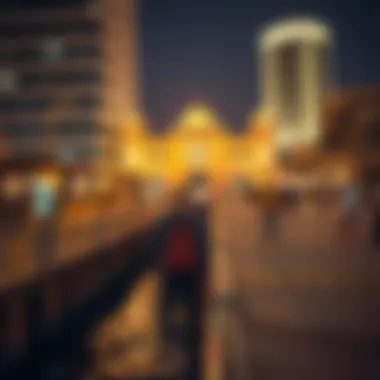

While the Metro is generally considered a reliable option, during peak hours it can become congested. This bridge between the traditional and modern ways of transportation allows visitors to experience both the heritage and the progressive nature of Dubai.
Bus Services
Bur Dubai Abra Station is also linked with several bus routes that cater to commuters looking for more extensive options to travel around the city. These bus services are excellent for those who may not wish to take the abra daily, providing alternatives that ensure no one is left behind.
- Wide Accessibility: With multiple routes converging at the station, residents can choose their destination without hassle. This optimizes travel times and offers flexibility.
- Affordability: Bus services are often more budget-friendly than taking an abra or taxi. For many expatriates and locals, this is a consideration in their daily commutes.
However, bus services may face challenges too. During rush hour or on weekends, delays can sometimes occur, due to heavy traffic conditions typical in Dubai's urban landscapes.
In summary, the Bur Dubai Abra Station stands out not only for its historical and cultural significance, but also for its role in enhancing transportation integration, linking communities, and facilitating public transport connections.
This intricate web of transportation options makes it a fundamental component in Dubai's urban mobility, adding considerable value for residents and travelers alike.
Cultural and Economic Impact
The Bur Dubai Abra Station holds more than just practical importance within Dubai's transportation network; it represents a significant cultural and economic hub. This dual role enhances the station's relevance, affecting locals and visitors alike. Understanding both the cultural and economic impacts enriches the view of how public transportation intertwines with the city's identity and vitality.
Tourism and Local Attractions
The station serves as a gateway to some of Dubai's most iconic attractions. Visitors can easily access the historic Al Fahidi District, where the traditional wind towers remind everyone of the city’s rich heritage. Not to be overlooked is the bustling Textile Souk, where vibrant fabrics and intricate designs draw tourists searching for unique souvenirs.
Moreover, the proximity to the picturesque Dubai Creek enhances its cultural significance. Cruises along the creek not only showcase the magnificent skyline but also enable tourists to experience Dubai’s maritime history.
In essence, the Abra Station connects its users to a world pulsating with life, architecture, and stories that reflect the multicultural essence of Dubai. It transforms a simple commute into a cultural exploration.
Economic Contribution
Employment Opportunities
The station significantly impacts local job creation. The area surrounding it buzzes with activity, providing numerous employment opportunities, especially in the tourism and retail sectors. From shopkeepers to tour guides, countless individuals find work through the influx of visitors. This symbiosis between transportation and employment ensures sustainability in the local economy.
A robust characteristic of the employment landscape near the station is its diversity. Part-time opportunities cater to students and expatriates, while full-time positions serve local residents, offering decent wages amid fluctuating economic conditions.
However, challenges remain. The competition for positions can be fierce, and the seasonal nature of tourism can lead to job instability. Nonetheless, the station's role as a catalyst for employment is apparent. It provides a foundation for individuals seeking methods to earn a living, promoting the growth of a resilient financial ecosystem.
Market Accessibility
Market accessibility is another critical aspect of Bur Dubai Abra Station’s economic impact. The station's strategic location means that local markets are just a short Abra ride away, connecting buyers to countless vendors. It supports local businesses by providing a constant stream of potential customers who might otherwise be unaware of hidden gems.
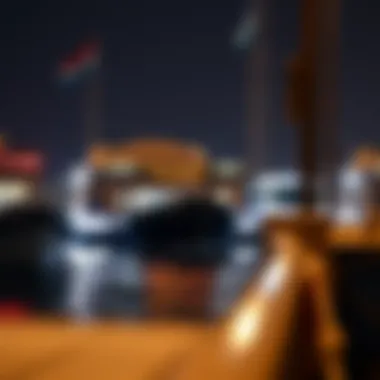

Moreover, the economic characteristic of market accessibility creates a sense of community. Residents can easily obtain goods that range from traditional spices to modern electronics. Encouraging local trade helps the economy while fostering relationships between different socio-economic groups.
But, it is worth noting that while accessibility enhances economic benefits, it can also lead to overcrowding in peak tourist seasons. Balancing growth with sustainability becomes key; thus, ongoing development plans will be essential to managing this unique tension as the area attracts more visitors.
In summary, the Bur Dubai Abra Station is more than a transit point; it's a cultural and economic lifeline. Through its direct link to attractions and the way it boosts local employment and market engagement, it plays a pivotal role in shaping the socio-economic landscape of Dubai.
Visitor Experience
Understanding the visitor experience at Bur Dubai Abra Station is essential for grasping its role in Dubai's transport network. This station is not just a point for boarding abra boats; it’s the gateway to a rich cultural journey. From the moment visitors arrive, they are greeted with the sights and sounds reflective of Dubai's vibrant heritage. Navigating the station may seem straightforward, but it entails appreciating both its historical significance and functional utility. The experience transcends mere transportation; it is about connecting with a living part of the city.
Navigating the Station
When you step into Bur Dubai Abra Station, there’s a certain bustle in the air. Travelers bustle about, and the air is filled with a blend of aromas wafting from nearby eateries. The layout is simple, with clearly marked signs guiding you to the docking areas. Expect to see various booths selling tickets and providing information. Visitors should be aware that the ticketing process is swift; just a small fee grants access to the serene ride across Dubai Creek.
The waiting area can get a bit crowded during peak hours, especially on weekends. It's completely normal to mingle with tourists, locals, and families enjoying the city’s charm. Moreover, a short stroll around the station gives you a glimpse of the surrounding area, including traditional markets. Don’t forget to take a moment to soak in the aesthetic appeal of the wooden abra boats lined up, ready to cruise across the water.
Tips for First-Time Users
For those who may be venturing to Bur Dubai Abra Station for the first time, a few handy tips can make the experience smoother:
- Arrive Early: Peak times can lead to longer waits for boats. Arriving early allows you to enjoy a leisurely experience.
- Cash is King: Have some cash on hand. The ticket machines may not accept cards, making cash the most reliable option.
- Go at Sunset: If possible, catch an abra ride during the evening. The view of the sun setting over Dubai Creek is simply breathtaking.
- Respect Local Customs: While Dubai is very welcoming, it’s best to dress modestly and be mindful of cultural practices.
- Keep an Eye on the Schedule: The working hours might change based on holidays or events, so check the schedule in advance.
"First-time visitors often find themselves enchanted by how the old meets the new — a ride across the creek captures the essence of Dubai’s rich past and its dynamic present."
Through these tips, visitors can navigate with ease and appreciation for their surroundings. The experience isn’t just about transport; it’s about immersing oneself in the culture and vibrancy of Dubai.
Ending
The Bur Dubai Abra Station stands as a vital artery in the pulsating heart of Dubai's transport network. Understanding its location and significance is not just an academic exercise; it reveals the intricate web of cultural and economic interactions shaping this vibrant city. The station connects diverse communities, weaving together traditions and modernity in a strikingly unique manner. Its historical backdrop adds depth, offering insights into the evolution of transportation in Dubai, where the past and present coalesce in a tapestry of mobility.
Summary of Key Points
- Historical Context: The Abra Station has deep roots, symbolizing the traditional mode of transport in Dubai before the advent of modern infrastructure. Its persistence showcases the city's commitment to preserving cultural heritage while adapting to contemporary needs.
- Community Connectivity: This station serves as a bridge, literally and figuratively, linking people from diverse neighborhoods and providing a vital transit point for both locals and tourists. It facilitates easier access to notable attractions, enhancing the flow of visitors across the region.
- Economic Implications: By integrating seamlessly with the larger public transport framework, the station supports economic activities in the area. It enables efficient movement, encouraging local businesses and stimulating employment opportunities within Bur Dubai.
- Tourism Enhancement: As a gateway to culturally rich landmarks, it plays a crucial role in promoting tourism. Tourists often find themselves captivated by close proximity to the bustling Textile Souk and historic districts, making the Abra Station a key component of their experience in Dubai.
Future Developments
Regarding future developments, there are whispers of transformative improvements around the Abra Station. With urban expansion in full swing, the station may see enhancements designed to accommodate increasing passenger volumes. Potential projects could include:
- Upgraded Facilities: Renovations may bring modern amenities to improve user experience, such as better waiting areas and enhanced safety features.
- Expanded Connectivity: There is potential to integrate the station further into Dubai’s growing metro and bus systems, making it more accessible for visitors.
- Sustainability Initiatives: Future plans might also incorporate eco-friendly practices, focusing on reducing the environmental impact correlated with transport within the city.
As Dubai continues to evolve, the Bur Dubai Abra Station is likely to reflect these advancements, reinforcing its role within the urban tapestry while maintaining its unique character.
The blend of tradition and modernity encapsulated in this station outlines not only its importance but its potential for fostering growth and community cohesion in Dubai's multifaceted landscape.
For further insights, you can explore additional information at Wikipedia, Britannica, or relevant community discussions on Reddit.
Engaging with these resources will deepen your understanding of the Bur Dubai Abra Station's pivotal role in an ever-changing urban context.



